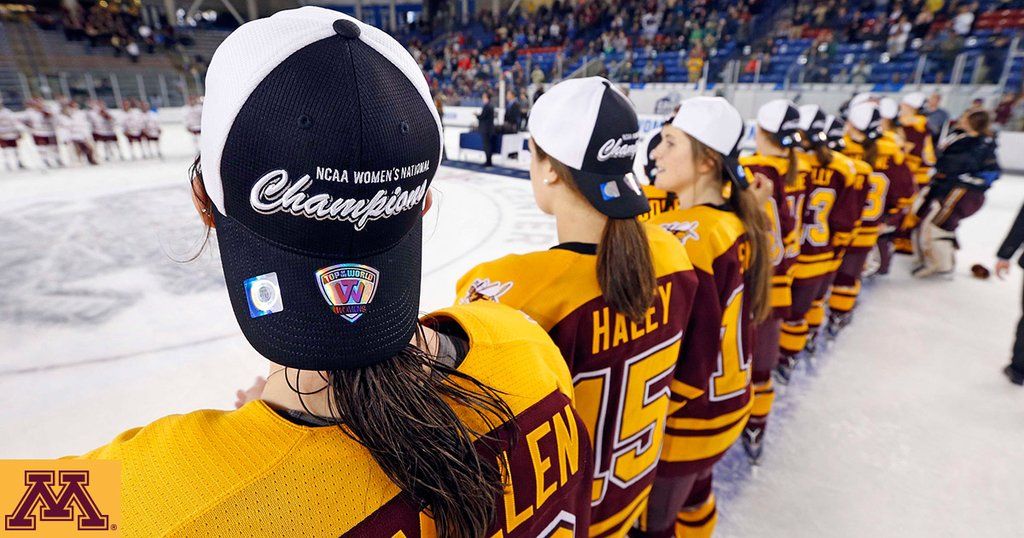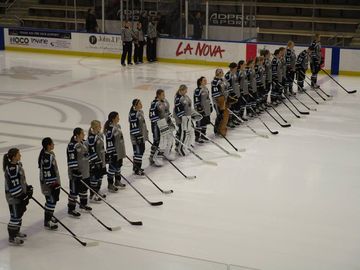Names and Legacies
Women’s college hockey is cyclical. Women come in, play for four years, and move on. Unlike the men’s side, players don’t leave early. They play their four seasons of eligibility and end their careers.
The biggest bump in that routine comes when women take a season off to prepare for an upcoming Olympics. Even still, every year teams experience loss and graduate players. It’s a part of the game.
However, the graduating class of 2016 may be the most talented group of players to ever leave the game at once, on either the men’s or women’s side.
Topping the list of departing talent are three Patty Kazmaier winners in Minnesota’s Amanda Kessel, Boston College’s Alex Carpenter, and Northeastern’s Kendall Coyne. They’re all once-in-a-lifetime type players; the kind of generational talent that doesn’t come along very often. These women have already made an impact on the college and international game -- they all played for Team USA in Sochi and have won gold at the Women’s World Championship.
Kessel is a household name who has done nothing but make national headlines since her surprise return from concussion symptoms for the final two months of the season. Carpenter helped to usher in a new era for the Eagles, leading them to their first national championship game. She is the face of a program that is now officially on the map for women’s college hockey. She is the Boston College career leader in every offensive category save short-handed goals. And Coyne is the Northeastern career leader in goals (140) and points (248). She also shattered the Hockey East career points record, surpassing it by 39 points. She set new HE records for career points (167), career goals (91), single-season points (55), single-season goals (30), points per game (2.39), and goals per game. (1.30).
Beyond those three, the list of departing players includes a ton of talent and key players, both in established and up-and-coming programs. There are five women who will represent their countries at the 2016 IIHF WWC.
Minnesota’s Hannah Brandt was a two-time Patty Kazmaier top-three finalist and was a top-10 finalist for all four years of her career. Boston College’s Haley Skarupa was a top-10 finalist the past two years. She and teammate Dana Trivigno are part of USA’s WWC roster.
North Dakota’s Shelby Amsley-Benzie is the North Dakota career record-holder in every goaltending category.
Clarkson’s Erin Ambrose helped lead them to two Frozen Fours in three years, including the only national championship not won by a WCHA school in 2014. She was a Patty Kaz top-10 finalist in 2014, when she led the nation in points by a defender. She’s the Golden Knights’ career leader in blue line points.
Harvard’s Emerance Maschmeyer is the program’s career leader in saves with 2,538, and she will play for Canada in the 2016 IIHF Women’s World Championships (WWC) next week as one of just three collegians on the roster. Her teammate, Michelle Picard, was on USA’s Olympic team in Sochi and will join them again for the 2016 IIHF WWC.
Nicole Hensley joined the Lindenwood Lions in just their second year as an NCAA Division I program. She is part of Team USA for the 2016 IIHF WWC and helped lead her team to upset wins over NCAA tournament teams Mercyhurst and Northeastern.
Bemidji State is graduating nine seniors who helped turn their program around. As freshmen, they won just six games. By their junior season, they had 21 wins and an upset over Minnesota to advance to the WCHA tournament championship game. They were ranked as high as sixth this season and finished it in the top ten.
Despite the turnover, Minnesota coach Brad Frost didn’t see the college game as a whole being affected. It’s simply the nature of the game.
“It’s an incredible senior class throughout the whole country... People graduate and new people show up and become the new fixtures of college hockey. Next year we’ll be talking about the next great group of seniors,” he said.
It would have been impossible to imagine a player having a season like Coyne’s just a few years ago. When Minnesota completed their perfect season, it seemed like an impossible feat never to be repeated, but Boston College was only one game away just three years later.
Despite the blow to several programs, Boston College coach Katie King Crowley said this means nothing but good things for the game. A 1998 Olympic gold medalist, Crowley couldn’t imagine this kind of talent playing collegiate hockey back then.
“I think really speaks volumes for the growth of our sport and how much it’s grown,” she said.
Minnesota captain, junior Lee Stecklein, wouldn’t go so far as to call it the end of an era, saying that’s not a thing that’s evident without some time passing.
It’s unlikely any player or coach would say that they think their program is going to suffer during the upcoming season, but if nothing else new came out of the Frozen Four (where Minnesota won their third national championship in four years), the underclassmen of each team showed that none of the programs are “done” when their stars depart this offseason.
Minnesota received immense contributions from National Rookie of the Year Sarah Potomak, as well as a goal in the semi-final from freshman Taylor Williamson. Frost said that while you need players like Kessel to play like the elite player she is, in order to win championships, you need the other players to step up as well. In making an impact on a big stage, the young Minnesota players showed they’re ready to step into the vacated spotlight.
“I think our team’s in good hands. Our coaches are amazing and they’ll do whatever they can to keep this team winning,” said Brandt, who was impressed with the poise and passion of the Gophers’ younger players. “This team is going to be the same. They expect to win every game.”
And while it’s never easy to replace a world-class athlete, Kessel herself said that no one player can make a difference.
“This team and this program is about a lot more than the individual players. We’re obviously losing a ton of talent and we have to find a way to regroup each year,” said Stecklein. “We have a great freshman and sophomore class. They stepped right in here and they showed up here at the tournament.”
The thing about having top-tier talent is that their skill is usually just one facet of their impact. For a school like Northeastern, having Coyne on the ice upped the school’s profile and helped with recruiting. But more than that, her work ethic and passion inspired and pushed her teammates, meaning that her impact will last far beyond her four seasons.
“She’s helped us achieve some milestones during her time and she’s put us back in the national spotlight. I’m grateful to Kendall for the five years she spent with us...I’ll be forever grateful for what she’s done for Northeastern on and off the ice. She’s created a culture at Northeastern that’s going to last a long time,” said coach Dave Flint at the Patty Kazmaier ceremony last Saturday.
Crowley agreed that despite losing the on-ice talent of her departing seniors, the legacy that they are leaving is as important as anything else they achieved during their careers.
“The six seniors have given so much to these younger players and have shown them how to be a BC hockey player,” she said. “The great thing about those kids leaving is what they’ve left to our younger players. And that is their work ethic, their leadership qualities. They all leave their own qualities behind to grow on... We have a lot of great players that are still here and that are looking to carry on the new tradition of Boston College women’s hockey.“
Rising Stars, New Blood
Not only is NCAA women’s hockey seeing an immense level of talent age out of their program, but we will likely see a shift in the power balance in the game due to their departure. Looking ahead, here’s how things may change in the NCAA next season as teams look to bounce back from losing so much talent.
On paper, Wisconsin, Quinnipiac, Princeton and Colgate -- all teams that were ranked and (with the exception of Colgate) in the NCAA tournament this year -- should not suffer greatly from a talent loss with graduation.
It’s all relative, of course, but Minnesota was not the same dominant powerhouse before Kessel returned. They’ll have a new goalie, but that goalie will have Stecklein anchoring the defense in front of her. They won't have the explosiveness of Kessel, but they’ll still have Potomak, Kelly Pannek, and Dani Cameranesi. They’ll also have an incoming class the features multiple members of Team USA’s gold-medal-winning U-18 national team.
After winning the title this year, the Gophers all said this one felt different. In year’s past, Minnesota’s dominance has been clear from the first puck drop. That wasn’t the case this season, especially once Wisconsin broke their long winless drought against the Gophers.
Maybe one player doesn’t make a difference, but the addition of Kessel did give Minnesota more line depth, allowed them to make some different pairings, and undoubtedly provided a confidence spark. The Frozen Four would have looked different without Kessel.
Boston College may be the biggest question mark heading into next season. Many are writing them off, but the Eagles’ underclassmen also made themselves known this past weekend. Hockey East Rookie of the Year Makenna Newkirk scored BC’s lone goal in the national championship game. Sophomore Patty Kazmaier top-10 finalist Megan Keller assisted on that goal and one on Friday. Sophomore goalie Katie Burt has been spectacular for the Eagles, as well.
BC will need players to step up into even bigger roles next season, but there’s a solid corps of players that lost just one game all season and have been to multiple Frozen Fours already in their careers. That, combined with similar rebuilding seasons from rivals Boston University, Northeastern, and Harvard, may be enough to see Boston College not lose much next season, as well.
Wisconsin graduates a handful of seniors, including senior captain Courtney Burke. But the corps of their top three lines and their defense remains, including USCHO Player of the Year, goalie Ann-Renée Desbiens.
The Badgers are the likely favorites on paper heading into the 2016-17 season. While other teams will need to see how the new pieces fit in, Wisconsin will hit the ice with the fewest question marks. They'll also bring in Minnesota Ms. Hockey Presley Norby, the high schooler who played with the US senior national team and won gold at Four Nations before winning the U-18 World Championships.
A team that quietly made their way through a successful season is Quinnipiac. Sophomore Taylar Cianfarano was ECAC Player of the Year and junior goalie Sydney Rossman was ECAC Goaltender of the Year. Freshman Melissa Samoskevich was on the conference All-Rookie team. The Bobcats finished the season 30-3-5 and ranked fifth in the country. They lost to Clarkson in the NCAA quarterfinal one week after beating them for the ECAC tournament championship.
Princeton has the ECAC Rookie of the Year in Karlie Lund. She led the league in scoring as a freshman. The Tigers were ranked as high as eighth this season, their highest poll placement in more than ten years. They ended the season 22-9-2 after losing to Minnesota (the eventual national champions) in the NCAA quarterfinals.
Colgate is graduating just three seniors from a team that finished right behind Princeton in the ECAC at 22-9-7. The finished the season ranked eighth in the country. The top of the ECAC is crowded and doesn’t appear like it will change much, but there’s young talent here that might snatch up any opportunity that the top four teams give them.
The graduation of these historic players is a boon for the professional leagues, and many of the top players have already been drafted into the NWHL. It also creates an exciting dynamic for younger players who have a chance to make a huge impact on a national stage and within their programs during their brief years of NCAA eligibility.
(Photo credit: @MinnesotaWHockey/Twitter)







